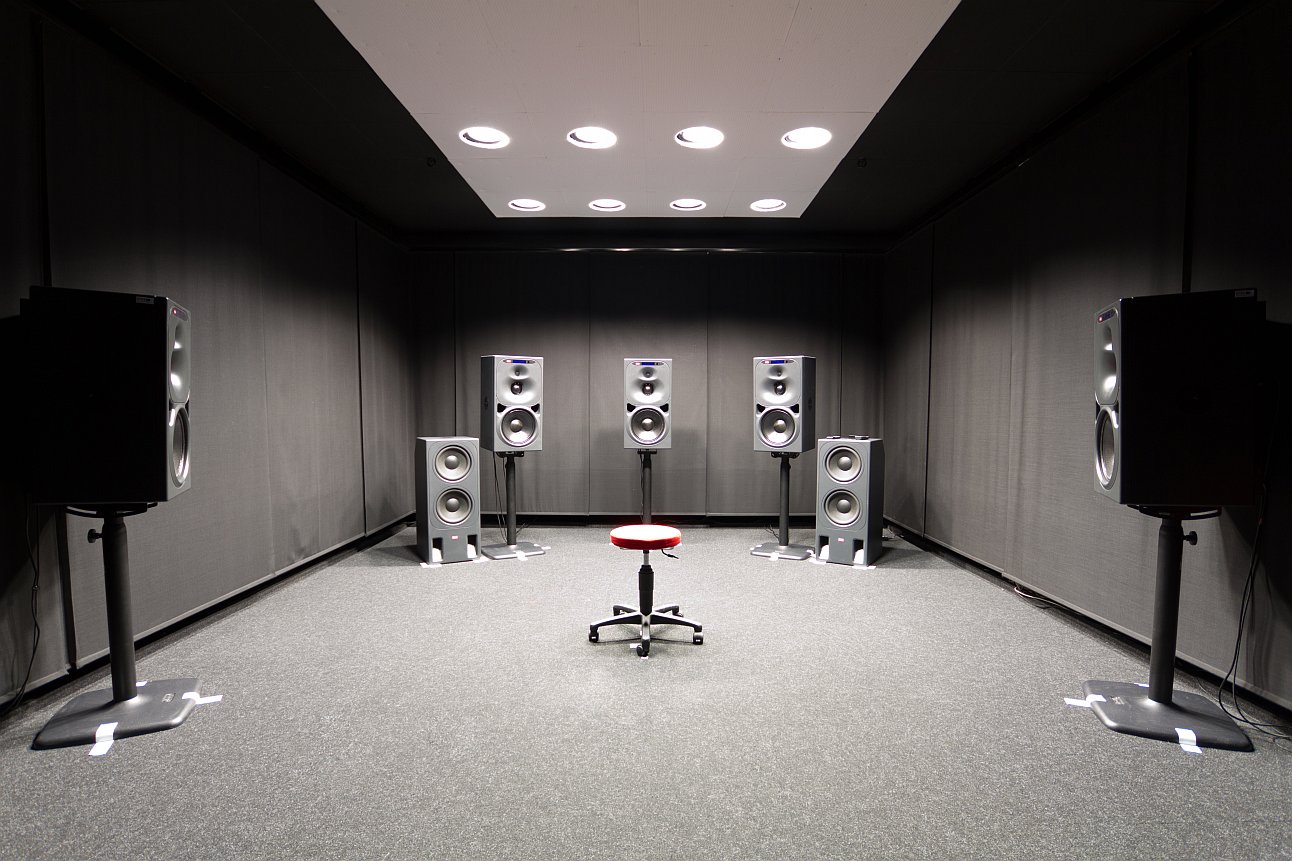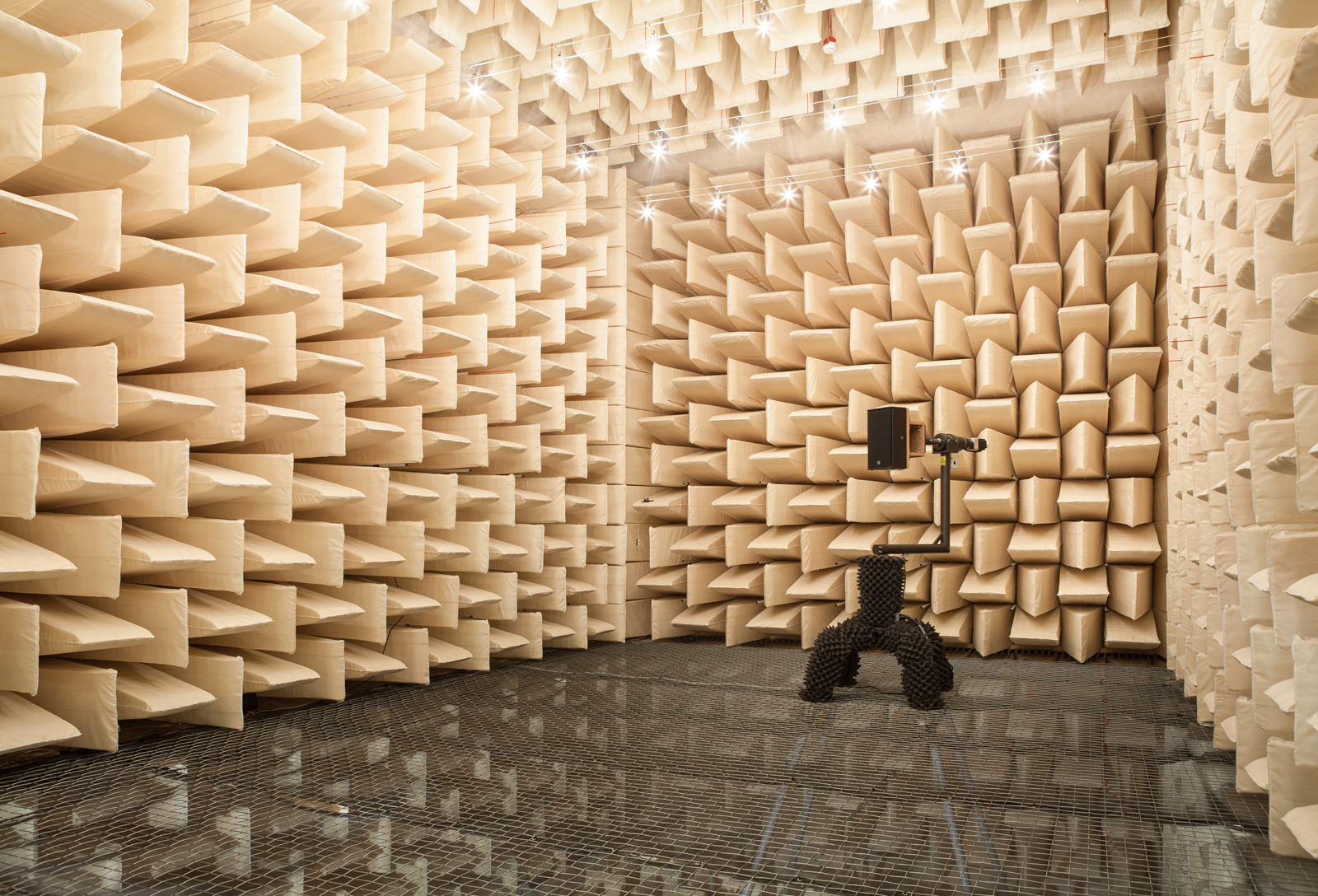This page gives you an overview of the institute's equipment. Fraunhofer IDMT is equipped with state-of-the-art acoustical laboratories that allow varied acoustical measurements and the further development of audio rendering processes and technologies.
Equipment
Tabbed contents
Ilmenau
3D Presentation Room

This special laboratory is intended for developing spatial audio-visual systems as well as for research on audio-visual perception.
- Room acoustics according to recommendation ITU-R BS. 1116-1
- 3D active stereo projector (3-chip DLP projector with 6,500 ansi lumen light power, SXGA+ resolution)
- Acoustically transparent screen for coupling with audio playout systems
- Trussing system with 80 mobile speaker fixtures
- Optical tracking system with 6 infrared cameras and a PC incl. control software
- Mobile absorber boards
- Scaleable multichannel speaker system with up to 650 single speakers
- Signal input via control room or network possible
- Loudspeaker wall
Wave Studio

This fixed sound system is used for further development of spatial audio output technologies based on Wave Field Synthesis.
- Sound system with 88 tweeters and midrange speakers and 4 subwoofers
- Room acoustics according to recommendation ITU-R BS. 1116-1
- Video screen and beamer
- Signal input also via external control room or network possible (12 x 64 audio channels via LWL + 12 XLR)
- Transmission media KVM, Cat6, LWL, XLR, BNC, DSub9 and Midi (flexible setup of further lines possible)
Testing and Measuring Lab

This state-of-the-art measuring lab allows independent electrical and acoustic measurements of audio hardware and measurements for quality evaluation under standard conditions.
- Room acoustics according to recommendation ITU-R BS. 1116-1
- 5.1 Surround Setup by Klein+Hummel (O500C, O900 with KPA 2220, ProM1012)
- mobile absorber boards
- Signal input also via external control room and network possible (10 x 64 audio channels via LWL + 12 XLR)
- Transmission media KVM, Cat6, LWL, XLR, BNC, DSub9 and Midi (flexible setup of further lines possible)
Anechoic Room

Our institute has an anechoic room that is among the most modern of its kind in Germany. Because of its size, equipment and frequency spectrum, it is ideally suited for precise acoustic measurements and listening tests.
- Usable size: 9.3 m long, 4.9 m wide, 7.2 m high
- Precision method (according to DIN EN ISO 3745)
- Lower cut-off frequency: 63 Hz, upper cut-off frequency: 20 Hz
- ELF – loudspeaker turning device for Balloon Measurement
- Loudspeaker Turntable Bruel&Kjaer Type 9640
- Microphone Cableway MSB (Norsonic)
- Setting up of steel grating is possible
- 105 holding fixtures at the walls (max. gross load hauled 100 kg)
- 36 holding fixtures at the ceiling (max. gross load hauled 100 kg)
- Video-surveillance
Printed Circuit Board Lab
In the Printed Circuit Board lab, printed circuit board prototypes for demonstrators and measuring devices can be manufactured in a short time with consistently high quality.
Equipment:
- Design workstation: circuit development and simulation; CAD programs for PCB production
- Circuit board plotter: Milling of copper-coated conductors with 150um spacing; drilling and milling of two-sided boards without through-hole plating
- Screen and stencil printer: application of solder paste on the board with the help of a paste screen; even distribution of the solder paste on the solder surfaces
- Manual pick and place machine: placement of the components with support from gripper arm and cameras (ball grid array placement also possible); several options for providing the components
- Reflow oven: baking of components to reduce humidity; soldering of assembled boards
- Soldering workstation: soldering of components that are not suitable for the soldering oven; desoldering of small components with hot air soldering irons; resoldering and repairs.
- Measuring workstation: Power supply and oscilloscope for commissioning and setting prototype parameters
Oldenburg
Audio Lab
The audio laboratory of the Oldenburg Branch for Hearing, Speech and Audio Technology HSA offers many opportunities in the field of testing and developing audio products. The focus is on compact loudspeaker and microphone systems as well as voice-controlled devices. The facility offers standard living room acoustics for testing products under everyday conditions, such as at the end customer's home. This is particularly important for speech recognition systems.
If required, larger, more reverberant rooms can be realistically simulated using artificial, electro-acoustic reverberation. In addition, there is an anechoic cabin (internal dimensions LxWxH 220x14x230cm) for measurements in which the room influence should be as low as possible, such as for the acoustic characterization of microphones or loudspeakers.
- Electroacoustic measurements on microphones, loudspeakers and audio products
- Frequency response (electrical/acoustic)
- Noise (electrical/acoustic)
- Maximum sound pressure; power handling after distortion, electrical and mechanical destruction
- Loudspeaker parameters: Linear (e.g. TSP), non-linear (various distortions)
- Dispersion characteristics
- Digital microphones: I2S, PDMT
- Speech recognition systems (FAR, FRR) according to standard and customer-specific test setups
- Structure-borne sound measurement via acceleration measurement or 1D laser
- Audio recordings
Audiometric Booths
A total of nine acoustic measuring booths with a size of 3 to 29 m2 are available to the Institute for acoustic analysis. In addition to psychoacoustic fundamental research, the booths can also be used for measuring standard-audiometric parameters as well as complex free range setups and ERA/OAE devices.
Anechoic Room
Because of its size, equipment and frequency characteristic our anechoic room is ideally suited for precise acoustic measurements and psycho-acoustic tests. Additional Equipment is available for accurate sound-source localization experiments.
- lower cut-off frequency 50 Hz
- level of background noise lower than hearing threshold
- spring supported absorber wedges (1.5 m long) to avoid frequency vibrations of 5 Hz and higher
- Equipped for multi-channel playout and audio recording
Communication Acoustics Simulator
With the unique Communication Acoustics Simulator the acoustics of nearly every listening room can be simulated. The acoustic parameters of this room – reverb time and acoustic room size – can be changed and virtual sound sources can be placed inside. This way, acoustic characteristics of office buildings, cathedrals, concert halls and even train stations and bathrooms can be simulated. The room can be used for research projects that require definite, variable acoustic room characteristics and specific background noise situations.
- 93 m2
- electronic acoustic VRAS (Variable Room Acoustic System) for generating different reverberation and early reflection patterns
variably set reverberation time of approx. 0.4 s to 6 s
- Audiosignal matrix (LCS) with special DSP hard- and software
- 16 microphones fixed invisibly to the ceiling
- 24 loudspeaker channels (12 for reverberation, 12 for early reflection)
- Subwoofer for low-frequency extension and for dolby surround input in VRAS
- 8 input channels for surround noise scenarios and dolby surround performances
- Connectors and patch fields for temporary microphones and loudspeakers
- Audiovisual media equipment
- Induction system for the hearing impaired
Equipment for User Studies
- Video lab with one-way window
- Eye tracking recorders
- Neurophysiological measurements of cognitive stress by electroencephalography (EEG)
- mobile, wireless 24-channel EEG
- Neuropsychological test batteries for testing hearing capability, memory and executive functions
Prototyping Workshop
The workshop of the Fraunhofer IDMT in Oldenburg is suitable for the implementation of designs in the form of prototypes. The "Audio System Technology", "Automatic Speech Recognition" and "Acoustic Event Detection" groups in particular build and test prototypes here.
Two 3D printers, soldering workstations and other technical equipment are available for this purpose. The areas of application for the developed systems are in the fields of smart home, health and care or, for example, in human-technology interaction.
- Two 3D printers
- soldering equipment
- Column drilling machine
- flex
- saw
- milling machine
- Workbenches
Sound-Technologies-Lab
Showroom and study lab with home environment
The Sound Technologies Lab at the Fraunhofer IDMT is both a showroom and a study laboratory, set up as a living and home office environment. Here, scientists can integrate newly developed technologies from the fields of acoustic event detection and speech and event recognition into concrete application scenarios. The laboratory also offers the opportunity to evaluate the technologies and their operating concepts together with partners from industry and research. For example, voice assistants for smart speakers could be tested in the living environment. This provides a comprehensive insight into research in the field of intelligent voice assistants.
In addition, the Sound Technologies Lab is certified in accordance with DIN 18041 "Audibility in small to medium-sized rooms" and is therefore ideally suited as an environment for evaluation and user studies.
VR Lab
The VR laboratory at the University of Oldenburg is a specialized lab for reproducing (virtual) 3-D sound fields and is mainly used by the Fraunhofer IDMT for listening tests regarding localization abilities and technical measurements
- 3-dimensional 86-channel loudspeaker system with 48 loudspeakers on a horizontal ring (diameter approx. 4.8 m)
- 12, 6 and 1 loudspeaker each at ± 30, 60 and 90 degrees elevation
- The surrounding room is semi-anechoic and equipped with 75 cm foam wedges.
- A (removable) cylindrical screen for 180-degree video projection or head-mounted displays for visual presentations can be used.
Wind Tunnel
Fraunhofer IDMT uses the wind tunnel of the Oldenburg University to analyze influences of air flow on audio systems, e. g. on multimedia and communication devices worn at ones body.
- Construction type: open measuring section, closed circuit; "Göttingen Type"
- Speed: max. 50 m/s
- Intensity of turbulence: under 0.3 %
- Beam width: 1.0 m x 0.8 m
- Drive: Radial fan with DC motor 77 kW
- Flow measuring technology: 2D laser Doppler anemometer (LDA), hot wire anemometer, miniature-fan anemometer, acoustic turbulence probes, particle-image-velocimetry (PIV)
- Acoustic measurement equipment: directional microphone array; in-flow measurements with flow microphones; correlation procedures for pseudo sound suppression
Further Equipment
- Usability lab with video and analysis equipment (TU Ilmenau)
- Multimedia studio equipment (TU Ilmenau)
- Listening lab according to BS standard 1116 (TU Ilmenau)
Acoustics
- Measurement equipment and tools for sound field analysis, vibration measurement, array measurement and analysis of absorption characteristics
- Kundt's tube AFD 1000 for measuring sound reflexion, transmission and absorption
- Klippel R&D system with scanning vibrometer for measuring loudspeakers
- Software for measuring loudspeakers (Monkey Forest, MLSSA)
- Klein+Hummel 5.1 surround setup (K+H O500C, K+H O 900, K+H Pro M1012)
- Standard measuring system Soundbook MK2 with SAMURAI 2.0
- Sound intensity probe Gefell SIS 90
- Multi channel measuring system (64 channels, Akustik Technologie Göttingen with si++ Workbench)
- Dodekaeder Outline Globe Source with subwoofer and GSA
- Globe Amp (sound source for room acoustic measurements)
- Measuring microphones (Gefell MK221, Gefell M360, Earthworks M30BX, Earthworks M30)
- Audio Analyzer Rohde und Schwarz UPL/UPD
- Digital oszilloscope (4 Tektronix TDS 3054B, 1 Tektronix TDS 7104)
- Headphones (Stax Lambda Pro, AKG 701, AKG 274, Sennheiser HD600, Sennheiser HD280, Beyerdynamic DT 770, Beyerdynamic DT 880)
- Head simulator Cortex Instruments Manikin MK2
- NTI Acoustilyzer, Analyzer XL2, Minirator MR Pro, Digilyzer DL 1,
- Diriator DR2
- PA loudspeakers (Alcons Audio LR14, Kling & Freitag CA106, GAE BR118)
- Audio editing suite (28 channels ProTools)
- Noise planning software Soundplan
- Loudspeaker development software LEAP 5, LspCAD
- Room simulation software EASE, ULYSSES
- Laser Scanning Vibrometer Polytec PSV-400
- FEM simulation software Comsol Multiphysics
 Fraunhofer Institute for Digital Media Technology IDMT
Fraunhofer Institute for Digital Media Technology IDMT











